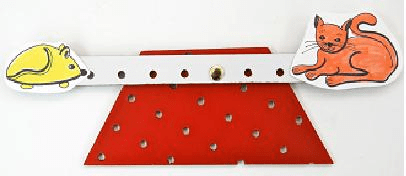Force and motion
Mech-a-Blocks
7. Which Way Will It Go?
Overview
This lesson compares the directions of the input and the output of a see-saw. Do the figures on the two sides go in the same or opposite directions? Then they explore how they could change the design to make both figures go the same way.
Procedure
-
The See-Saw: Demonstrate a Mech-a-Blocks model of a see-saw, such as the one in Figure 1. Do not operate it yet.
 Figure 1: Mech-a-Blocks see-saw
Figure 1: Mech-a-Blocks see-saw- Which way the mouse will go if the cat goes up?
- What about if the cat goes down?
Record their answers, using a diagram and arrows on chart paper. See Figure
 Figure 2: Which way will the mouse go?
Then provide each student with cat and mouse cut-outs, and ask each one to make his or her own see-saw. Ask them to try the experiment with their own constructions:
Figure 2: Which way will the mouse go?
Then provide each student with cat and mouse cut-outs, and ask each one to make his or her own see-saw. Ask them to try the experiment with their own constructions: - If your cat goes up, which way does your mouse go?
- If your cat goes down, which way does your mouse go? Next, review the words “same”, “opposite”, and “direction”:
- Direction tells which way something is going. What direction did I push the mouse? ____. What direction did the cat go? ____
- Same means that if one goes up, the other goes ___. If one goes down, the other one goes ____.
- Opposite means that if one goes up, the other goes ___. If one goes down, the other one goes ____. Finally, ask whether the see-saw makes the cat and mouse go in the same directions or opposite directions. Write the answer on chart paper. Science Notebook
- Draw your see-saw.
- Use arrows to show which way the mouse goes when the cat goes down.
-
Making them go the same way: Ask the students: “On the see-saw, the mouse and the cat go in opposite directions. What if the cat wanted to go in the same direction as the mouse? How could I change this see-saw to make that happen?” Provide time for them to experiment with their Mech-a-Blocks. Try out any suggestion they come up with and test it to see if the input and output go in the same direction. If they don’t come up with it, present your own solution: first, remove the see-saw from the base and reconnect it three holes from the right end. Attach the cat a little to the right of the mouse. See Figure 3.
Figure 3: Putting the cat near the mouse Do you think this will work? What did I change?
-
Science Notebook:
- Draw a see-saw that makes the cat and mouse go in opposite directions.
- Draw a see-saw that makes the cat and mouse go in the same direction.
-
Discussion: Conduct a whole-class discussion comparing the two kinds of see-saws.
- What do you notice about where the fixed pivot has to be when the cat and mouse go in opposite directions?
- What has to be true for them to go in the same direction?
-
Outcomes:
- Students distinguish between up and down movement, and compare two movements to see if they are in the same or opposite directions.
- They know that when the fixed pivot is in between the input and output, the two motions will be in opposite directions.
- They know if both input and output are on the same side of the fixed pivot, the input and output will move in the same direction.
-
Assessment: Show students a mechanism that works like a see-saw, with the cat and mouse on opposite sides of the fixed pivot.
- How would you change it to make the cat and mouse go in the same direction?